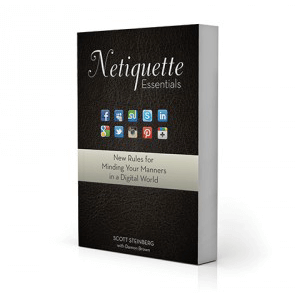 PROBLEM Social-media platforms like Facebook, Twitter, Instagram, and LinkedIn give you more ways than ever to express yourself. How do you know what to share and what to keep to yourself — especially when it comes to maintaining a professional online presence?
PROBLEM Social-media platforms like Facebook, Twitter, Instagram, and LinkedIn give you more ways than ever to express yourself. How do you know what to share and what to keep to yourself — especially when it comes to maintaining a professional online presence?
SOLUTION In Netiquette Essentials: New Rules for Minding Your Manners in a Digital World, futurist Scott Steinberg offers a framework for “equipping contemporary high-tech users with the tools and training they need to not only be courteous and respectful of others, but also responsible digital citizens” — including tips for being a responsible social-media user:
- Understand that each social network has its own rules of conduct, social norms, and methods of interaction.
- Assume that everything you post online can be seen by others, as even major social networks have suffered privacy breaches.
- Do not share information that online friends have shared with you in confidence, e.g., quoting someone’s private tweet to you.
- Log out of all your social networks when finished using them, and when you are using a computer or mobile device that isn’t yours.
- Realize that everything posted online lives on the internet permanently, and may be available for public viewing. › Never forget: Despite their seeming intimacy, social networks are among the most public of spaces — it’s important to conduct yourself on them as you would in any shared setting.
- You reserve the exclusive right, and it is wholly appropriate, to decline friend requests from strangers.
- Privacy and personal comfort are paramount: At no point should you feel compelled to respond to messages or queries from people you don’t know.
- Before posting on others’ profiles or walls, or tagging them in your own posts, consider how your actions and/or statements may be perceived, and if they may potentially cast friends in a negative light and/or embarrass them.
- Use privacy settings to limit who can view your posts and shares.
- When asking someone you don’t know to be your friend, send a short message explaining who you are and why you’re attempting to contact them.
For more information: akeynotespeaker.com/books.

